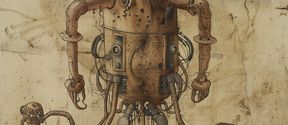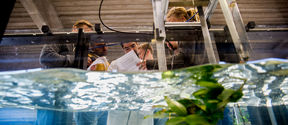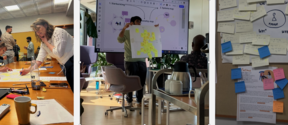Leadership for organizational creativity—creating conditions for creativity

Organizational creativity is the creation of a valuable, useful new product, service, idea, procedure, or process by individuals working together in a complex social system
– Richard W. Woodman, John E. Sawyer & Ricky W. Griffin
Creativity results from the interaction of a system composed of three elements: a culture that contains symbolic rules, a person who brings novelty into the symbolic domain, and a field of experts who recognize and validate the innovation.
– Mihaly Csikszentmihalyi
Managing creativity is an ongoing inquiry in which a key strength is the ability to resist pressures that delegitimize uncertainty, questioning, dialogue, and experimental action.
– Barbara Townley & Nic Beech
In the complex and continuously changing institutional environments of today, radical creativity is said to be crucially important for organizational success. According to Aalto University top management, radical creativity is needed for addressing complex systemic problems and for managing change by actively inventing and creating desirable futures. Radical creativity is an essential element of the Aalto culture of excellence. It is not so much about doing things better but rather doing things radically differently to advance what management scholars Kevin Corley and Dennis Gioia (2011) call revelatory and transformative contributions to theory and practice. It is about inventing new modes of thinking, being, feeling, and doing that are instrumental for fosteringhuman and planetary flourishing.
Scholars and practitioners alike seem to agree that creativity is a feature of people’s behavior in a particular situation and organizational context. It involves the ability of an individual or group of individuals to produce new, original ideas and innovative solutions to problems—only some of which might eventually be deemed strategically or financially feasible to implement in the organization.To demonstrate such creativity, individuals need to have and cultivate particular skills and abilities. A systematic literature review carried out byEunice M.L. Soriano de Alencar (2012) suggests that people who score high on creative achievement tend to generally be individuals who take initiative and demonstrate independence of judgment, flexibility, openness to new ideas, persistence, self-confidence, tolerance to ambiguity, disposition to take risks, and ability to learn from their mistakes. For organizations and the society at large,creativity is thus an important resource. It empowers the individuals, teams, and communities to actively seize opportunities, effectively respond to challenges, and successfully cope with unanticipated situations.
Five tips to improve conditions for creativity
While creativity is arguably a skill or capacity of an individual, it also requires collective effort and empowering leadership.
- Establish organizational structures and practices for experimentation
As critical management scholars Barbara Townley and Nic Beech (2010) have argued, managing creativity is not so much about control and constraint; it rather calls for stimulating, supporting, inspiring, communicating, and putting values into action. Leadership for radical creativity calls for establishing organizational structures and practices that not only encourage but also enable and support individual and collective creativity—structures and practices that foster collective curiosity, tolerance for uncertainty, and organizational practices that encourage experimentation, risk-taking and learning from failure.
- Enable creativity through job design, employee engagement, and high-quality leader-subordinate relationships
Research carried out by Greg R. Oldham & Markus Baer (2012) suggests that to enhance creativity, organizational leaders need to work toward creating organizational contexts and work environments in which employees at all levels of the organizational hierarchy not only have access and are exposed to new and different ideas, perspectives, and approaches but also feel fully engaged in their work. In practice, they argue, this can be achieved through job designs that challenge individuals and teams to explore new sources of information to generate novel and creative ideas, developmental (instead of judgmental) practices of evaluation, and high-quality leader-subordinate relationships that are based on trust, mutual liking, and mutual respect.
- Develop your emotional intelligence
For enhanced organizational creativity, it is important that leaders are willing and able to model the way. And according to Pamela Tierney (2003) leaders who score high on emotional intelligence (Goleman1998) and intuition may be better able to do so. Leaders who have the ability to perceive, understand, and manage their own emotions as well as recognize and influence the emotions of others have found to be better able to connect with their team members, create a positive work environment, and effectively manage conflict.
- Foster trust and open-mindedness: remove excessive hierarchies and centralization
As regards factors that inhibit organizational creativity, scholars seem to agree that creativity is stifled first and foremost by a rigid, bureaucratic organizational culture with excessive hierarchies and centralized power. The authoritarian attitudes and intolerance for difference and divergent thinking that such culture breeds seem to be far from conducive to creating an organizational environment where taken-for-granted assumptions can be problematized and crazy ideas open-mindedly explored to generate and implement paradigm-shifting ideas that go beyond the incrementalcontributions and improvements.
- Acknowledge the plurality of creativity – one-size-fits-all does not exist
It is crucial to underscore that a skilled leader recognizes professional creativity as a domain-specific skill and ability. Within the academic setting, fostering organizational creativity can only be achieved through tailored guidance and facilitation that takes into account the specific context. Organizational creativity manifests differently across various fields of research and education. There is no single leadership approach that suits all situations and domains of creativity—there is no one-size-fits-all approach to leadership for creativity.
Finally, it is good to keep in mind that fostering radical creativity is not only 'a rational, discursive, or disembodied process that unfolds in a stable environment,' as Aalto Professor in Leadership for Creativity Astrid Huopalainen (2023: 320) has argued. Organizational leaders can learn a lot from the field of arts and artistic practice - how the importance of thinking freely, breaking norms, and experimenting is widely embraced as key to innovation and radical creativity.
Johanna Moisander, Professor, Aalto University Department of Management Studies
References
Corley, Kevin G., & Gioia, Dennis A. (2011). Building Theory about Theory Building: What Constitutes a Theoretical Contribution? Academy of Management Review, 36(1), 12-32.
Csikszentmihalyi, Mihaly (1997). Creativity: Flow and the Psychology of Discovery and Invention. New York: HarperCollins.
Goleman Daniel (1998). "What Makes a Leader?". Harvard Business Review.76: 92–105.
Huopalainen, Astrid (2023). "Innovation, AI, and Materiality: Learning from the Arts." In Rehn, Alf & Anders Örtenblad (Eds.), Debating Innovation. Perspectives and Paradoxes of an Idealized Concept (pp. 319-338). Cham: Palgrave Macmillan.
Oldham, Greg R. and Markus Baer (2012) Creativity and the Work Context. In Michael D. Mumford (Ed.), Handbook of organizational creativity (pp. 387-420). Waltham: Elsevier.
Tierney, Pamela (2008). Leadership and employee creativity. In J. Zhou & C. E. Shalley (Eds.), Handbook of organizational creativity (pp. 95–124). New York, NY: Lawrence Erlbaum.
Townley, Barbara & Nic Beech (2010) "Managing Creativity: Concluding Thoughts.” In Townley, Barbara & Nic Beech (eds.) Managing Creativity: Exploring the paradox (pp. 336-339). Cambridge: Cambridge.
Soriano de Alencar, Eunice M.L. (2012) Creativity in Organizations: Facilitators and Inhibitors. In Michael D. Mumford (Ed.), Handbook of organizational creativity (pp. 87-111). Waltham: Elsevier.
Woodman, Richard W., John E. Sawyer & Ricky W. Griffin (1993) Toward a Theory of Organizational Creativity. The Academy of Management Review, 18(2), 293-321.
Show other posts from this blog

Recommendations Towards Critical Trans-Disciplinarity
We would like to propose the following recommendations for the basis of strategic tools and methods for radically creative trans-disciplinarity.
Consequential Pragmatism
This blog text discusses methods which combine critical thinking with practicality in architectural design process.
The role of infrastructure in facilitating cross-disciplinarity
Hybrid concepts and metaphors across disciplines are created by working together in concrete material-spatial conditions.